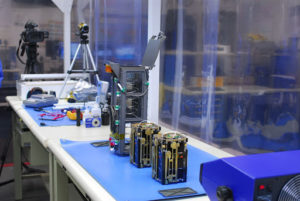Light plays an integral part in our lives. The significance of light cannot be overstated since it is essential to almost every facet of our modern civilization. It is employed in nearly every industry, including construction, telecommunications, transportation, entertainment, and textiles.
Light has data transfer uses, like optical fibers as well as optoelectronics. In addition, it is employed in laser printing and digital photography. It is utilized in optical fiber lasers, modulators, interferometers, a satellite platform, and sensors, among other things.
The science of photonics is long with-standing and has understood light’s importance. The term “photonics” is derived from “Photon,” which refers to the smallest unit of light. Thus, photonics can be described as photons’ process, generation, or manipulation to attain a particular function. The science of photonics involves emission, transmission, signal processing, amplification, and detection of light and answering questions like “does a photon experience space.”
Before we learn the nature of photonics in space technology, let us understand why is photonics important and what is photonics used for. In its most basic sense, photonics deals with the ethical application of light as a resource for the benefit of people.
Photonics has nearly endless scientific and technical uses, including diagnostic purposes, organic synthesis, telecommunications, and fusion energy. It improves people’s lives in various fields, including information and communications technologies, advanced manufacturing, military, health, pharmaceuticals, and energy. However, today, photonic technologies also have a lot of scope in space applications.
Scope of Photonics in Space
Photonic technologies were invented with the introduction of the laser in the 1960s. Since then, this technology has transformed the world of communications in numerous ways starting from integrated optics, fiber optics, micro-photonics, and electro-optical components.
Opposed to their conventional RF (radio frequency) counterparts, photonic technologies offer compelling advantages when used in space applications. Thus, the development of photonic technologies in space applications in signal processing, communications, and sensing is fast becoming a central theme.
With its distinct performance characteristics, photonics can be a technological breakthrough in the growing business of laser space communications. It has the potential to develop innovative bandwidth-hungry technologies and considerably increase the downstream space communications sector.
Photonic components are increasingly being investigated in navigation satellite platforms, Earth observation platforms, low Earth orbit (LEO) systems, and telecom satellite payloads due to benefits in bandwidth, mass, beam size, power consumption, as well as immunity to electromagnetic interference.
Use of Photonics in a Satellite Platform
The presence of photonic technologies has dramatically increased in space applications owing to their numerous advantages over conventional equivalent devices. The use of space photonics in a satellite platform offers benefits due to a few specific properties, which are discussed in the following section.
Photonics allows unlimited bandwidth, which is a fantastic advantage. Moreover, since photonics in space technologies result in short communication distances, there are reduced propagation delays at the satellite level.
These technologies also support any coding format. Additionally, they have improved mechanical properties, such as resistance to corrosion or contamination, and are mechanically flexible, lightweight, and reduced volume.
Photonics also helps decrease noise generation, especially when the satellites work close to the sensors. Most importantly, using photonic technologies results in mass reduction possibilities, leading to cost reduction throughout the handling and launching of the satellite.
Radio Frequency Payloads

Photonic systems are also being promoted to provide functionality to RF Payloads. The payloads are equipped with photonics for producing local oscillators, conducting optical down conversion, and manipulating the optical microwave signals by filtering them. The primary parts of such photonic systems include WDM components, optical switches, lasers, integrated circuits, and optical amplifiers.
Fiber Optic Sensing for a Satellite Platform
For a mission in space to become successful, satellite platforms that monitor of various parameters, particularly pressure and temperature, is critical. Numerous sensors are commonly employed to check the condition of the satellites from the production stage through the actual duration of the space mission.
Fiber optic sensing is a novel technology in satellite engineering that allows temperature, acceleration, strain, and rotation to be measured by modulating some characteristics of light flowing inside a fiber. The optoelectronics branch has been using these approaches to figure out how to apply this fiber technology in perspective space missions.
Fiber optic sensors rely on bidirectional optical signals that travel over optical fiber from the optical sensor source and back. This permits the interrogation electronics to be located away from essential portions of the satellite, reducing electromagnetic interference and eliminating safety concerns associated with the vicinity of explosive components from the propulsion system. Some other benefits include low weight, sensor response flexibility, compactness, high sensor capacity, high measurement resolution, and lower power consumption.
If photonics and optics are to enter the space industry as innovative tools, they must help boost the development of cost-effective inter-satellite systems and mega-constellations. This is only possible through the technological spin-in from some other industries, like telecommunications and industrial systems.
Final Thoughts
As the article above explains, the science of photonics has much scope in space technology. However, proper integration of different sectors and extensive research and development is needed to do the same. What do you like about the science of photonics? Let us know in the comment section below!

